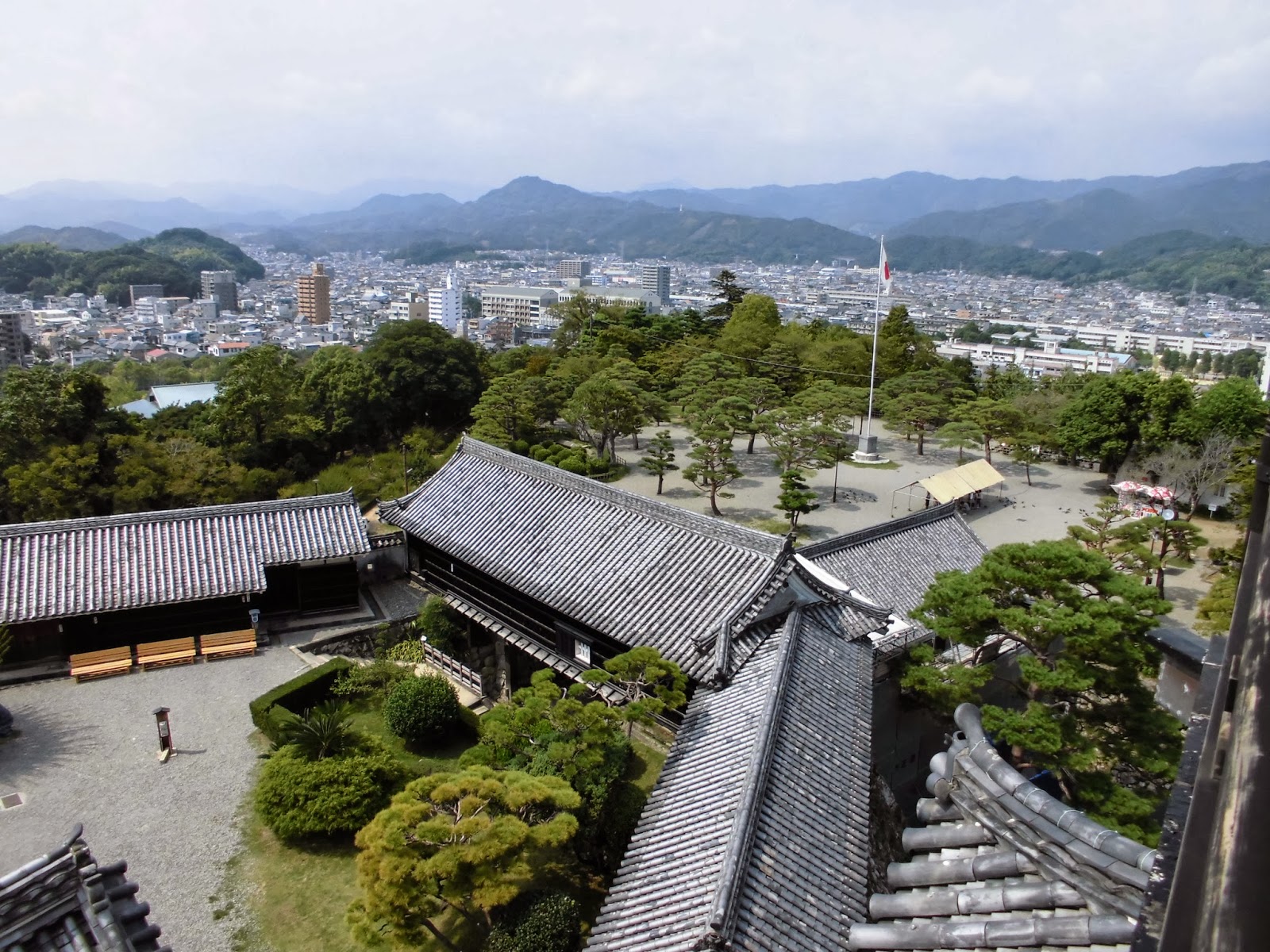Now, for the best part of any trip to anywhere: the castle!
Kochi City has a castle in it that at first glance is not particularly special. It's not particularly large, nor is the hill it's on particularly high. What makes it special is that it is one of the best preserved castles in Japan. Japanese castles, like most Japanese architecture, use a lot of wood, so they're prone to fires. Also, Japan is a country that suffers from earthquakes, tsunamis, typhoons, and 20th century world wars, so most of the castles in Japan have been partially or fully reconstructed at some point in the 20th century. Kochi Castle however, retains ALL of its Edo-period structures in the castle's central section. I do have to be honest here though, the castle was totally destroyed by fire once--in 1727--so, ok, sure, it's ONLY 300 years old. Sorry.
来たぞ!お城登場!どの旅でも、お城を訪ねるのはその旅の最高点になるだろう。高知城は見た目がそんなに特別だというわけではない。高知城より高いお城が日本に沢山ある。高知城より大きなお城も沢山ある。でも高知城は日本の中で、唯一江戸時代の建物が全て残っているお城だ。1727年に火災に遭った以来、一度も破壊されたことはない。台風、地震、火事、そして第二次世界戦争によって被害を受けた日本では、こんなに昔の建物が残っているのは本当に凄いことだ。
總算、古堡的post來了!地方沒關係、旅行的話、最好玩的部分就是參觀古堡。沒有古堡就不值去玩。高知的古堡真的不錯。不是日本最大的。也不是最高的。但是大部分的日本古堡、也被火災也被地震也被美軍破壞、後來在20世紀再建築了。可是高知城的建築都是18世紀的。日本古堡當中、也可以說是最好保存的。
A statue of Yodo Yamauchi, the 15th lord of Tosa, and a reform-minded (for the time) lord who was influenced by Ryoma Sakamoto and Shojiro Goto, and subsequently advocated for restoration of imperial rule. (As opposed to the rule of the Shogun, which was the case at the time.)山内一堂、幕末の土佐の大名だ。坂本龍馬と後藤像二郎の影響を受けて、明治維新の支援者の一人になった。
這個歐吉桑是「山內一堂」(ㄧㄚㄇㄚㄨㄑㄧㄧㄡㄉㄡ)。幕末時代土佐的大名。(「大名」是江戶時代、一個地方最強的統治者的意思。)他收到坂本龍馬和後藤像二郎的影像、支持明治維新了。
In the library next to the castle were some clothes designed by local high school students for a contest. This dress takes the theme of fish since Kochi faces the Pacific and has a major fishing industry.
お城の隣りの図書館に地元の高校生がデザインした洋服があった。下のドレスは高知の漁業を反映して作られた。高知の女性の皆に来て欲しい。
在古堡旁邊的圖書館有高中生想出來的衣服。下面的洋裝是因為漁業是高知的一個主要的產業。
Hipster kimono
変わった着物。かなりかっこういいと思う。
日本着物。但是模樣很特別。
Here's the main entrance to the castle grounds.
グラウンドへの玄関。
Look at this gate!
古堡的門。很厲害!
門は圧迫感が溢れている。
Here's a statue of Taisuke Itagaki. Yet another Kochi-born rabble-rouser, he was active in the people's rights movement in Meiji-era Japan. He also had a totally metal response to being stabbed, which you should definitely read about in the photo of the sign about him below.
板垣退助の銅像だ。さすが土佐の人間、この人も政府を悩ませた。自由民権運動に参加して、保守的なアホにナイフで刺された時、「吾死スルトモ、自由ハ死セン」と出血しながら発言した。かっこういいいいいい!!!!(まあ、実際に言っていない可能性は有るが、、、)
這個人是板垣退助(ㄧㄊㄚㄍㄚㄎㄧㄊㄞㄙㄎㄟ)。因為參加明治時代的自由民權活動、所以被一個想法保守的人刺傷了。他受傷了沒關係、就叫「我雖死、自由不滅!」好帥!
ITAGAKI MAY DIE, BUT LIBERTY NEVER!
An old well?
井戸だろう。
Kochi gets a lot of rain, and especially when a typhoon comes, it gets it all at once. As such, the castle was constructed with water drainage in mind. One of the tools used is these drains, which stick way out from the wall so that the draining water doesn't pour down the wall and cause it to fall apart.
高知は雨量が多くて、特に台風の季節は一気にいっぱい降って来るので、排水を考慮して高知城を作った。この変な感じで出ている石もその工夫の一つだ。これによって、排水は塀に当たらずに流れていける。雨が沢山塀に当たったら、崩れる恐れがある。
因為高知雨量比較多、所以為了不讓城堡收到雨的被害、設備這些水溝。如果雨直接流到牆、也許就讓牆破壞了。居然把水溝做得很長。
This is a statue of the wife of one of the lord's of Tosa. I can't remember her name, nor can I find it in the pamphlet about the castle I took home with me. She was known for being a major power behind the lord, and there was a popular TV historical drama about her a couple years back.
最近、土佐大名の奥さんについてのNHK大河ドラマがあっただろう?名前忘れたけど、この銅像はその奥さんだ。
塀の建て方も排水が関係している。大きな岩の間に、小さな石が置いてあるのは見えるだろう?適当に積んだ様に見えるかもしれないが、実は「野面積み」という方式だ。適当に積んだわけではない。空いている空間がかなり大きいので、水の流れを防がない。
Another feature of the castle related to water drainage is the stonework. The method used is one where small stones are stacked in the spaces between the big stones. There is lots of space, and this makes the structure better able to handle heavy water flow.
牆石當間有很多空間。這也算是對下雨的對策。水比較容易地流出來、不讓牆受傷了。
Ok, the Kochi tourism office needs to get on this vendor's case. I have no problem with people selling stuff on the castle grounds, but could this stand possibly clash with the castle any more than this? It's like she's trying to be offensively loud.
こんなに歴史溢れのスペースにはマジでこんなの勘弁してくれ。うざい。
跟氣氛非常不合適的攤。
The main tower. Admittedly, it's not as tall as some other castle towers in Japan, but it also looks even shorter here because we're already up on the raised courtyard around this tower. We're up pretty high at this point.
この時点では私達は既に結構登って来たので、建物は小さく見えるが、これは本丸だ。
Traditional Japanese architecture always has cool woodwork over the doorways.
It's nice that you're trying to motivate everyone to work, but maybe you could do that while NOT standing on the thing everyone is trying to pull.
また森さんが酔っぱらって皆の仕事を邪魔している。おい!降りろ!
Whaling operation
捕鯨的畫
凄くない?この写真に登場する木は全部18世紀のものだ。
This is all 18th century wood here! We're almost to the top of the main tower.
要快到最高點!
More whaling
A legitimately old castle. Pretty cool, huh? When your blood-pressure has settled, be sure to get busy clicking reload over and over again while you wait for my next post, wherein we visit the western part of Kochi Prefecture.
「なぜ?」なぜこんなに素晴らしいポストが終わるの?なぜお城の写真もっとないの?こんな問題を抱いて悩みながら、次回のポストを楽しみにお待ち下さい。
下次就是高知縣西南部!再見!































































No comments:
Post a Comment